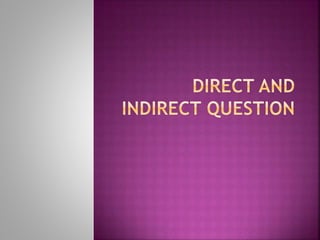
Forming Yes/No Questions in English
- 2. Direct questions – yes / no questions in English. A yes/no question is a question that can be answered by yes or no (or their equivalents, such as yeah or uh huh and huh uh) 1. He likes swimming. 2. He can swim long distances. 3. He is a good swimmer.
- 3. To make sentence 1 into a question, you need to add does. The does goes before he. Does is only used if the subject is he, she or it – in all other cases, use do. The verb like goes after the subject, but it doesn't have an 's' on the end. Remember: after auxiliary verbs (like do, does, have, can, etc.) the verb is in the infinitive, without 'to'. "Does he like swimming?" Not "Does he likes swimming?" or "Do he like swimming?"
- 4. If the sentence is in the past tense (he liked swimming), we use the past form of 'do' or 'does', which is did. The verb 'like' is still in the infinitive without 'to'. For example, "Did he like swimming?" Not "Did he liked swimming?" To make sentence 2 into a question, you don't need to use 'does' because you already have an auxiliary verb – can. So you put the can before he. "Can he swim long distances?" Not "Can swim he long distances?" or "Does he can swim long distances?" To make sentence 3 into a question, use is as the auxiliary. "Is he a good swimmer?" Not "Does he is a good swimmer?" or "Does he be a good swimmer?"
- 5. What is your name? Why do you want this job? How much do you earn? How soon can you start? When did you see the advertisement? Where do you live? Which newspaper did you see the advertisement in? Who gave you my name?
- 6. After the "wh word" (what, why, how, when, etc) comes the auxiliary (do, does, did or can), then the subject (you) , then the rest of the question. Note: if 'who', 'which' or 'what' are the subject of the question, you don't need an auxiliary. For example, "What happened?" Not "What did happen?" The thing that happened is what – the subject of the question. "Who saw you?" Someone saw you –
- 7. Compare with "Who did you see?" You saw someone – who was it?) "Which company made a profit?" A company made a profit – which company was it? Compare with "Which company did you work for?" You worked for a company – which one was it?
- 8. If you want to ask a question that is quite sensitive, try using one of the indirect phrases below: Can you tell me… Could you tell me… I'd be interested to hear… I'd like to know… Would you mind telling me…
- 9. These questions are followed by either about, a "wh word" or if. Then you add the subject, then the sentence. You don't need an 'auxiliary', such as 'do', 'does', 'did', or 'can'. "Can you tell me what you like most about your present job?" Not "Can you tell me what do you like?" "I'd be interested to hear about your experiences." "Would you mind telling me if you have applied for a similar position before?"
- 10. Exercises I. Make the appropriate Yes/No question for these anwers! No, I don’t. I don’t know your brother Jane eats lunch at the canteen every day It wasn’t foggy yesterday I slept well last night She can’t play piano The new class will begin
- 11. 1. How much does this book cost? 2. What time is it? 3. Where is the post office 4. What country is Anna from? 5. When did David arrive 6. Why was Kathy absent yesterday? 7. When does the semester end? 8. What is Sue talking about? 9. What did he say? 10. What does this word mean?
